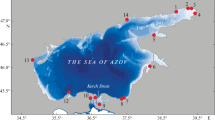Abstract
Amplitudes and phases of the tidal constituents are computed from harmonic analysis for the ports of Aden and Djibouti from the hourly Sea Level data for the year 2008 at these locations. The analysis shows that the tides are of mixed nature in the area. The ratio F = K1 + O1/M2 +S2 gives a value of 0.87 and 0.85 for Aden and Djibouti stations. The high astronomical tide and low astronomical tides are respectively 1.138 m and − 1.681 m for Aden port and 1.144 m and − 1.671 m for Djibouti port. Tidal amplitudes and phases at both stations are found closely similar. The major constituents of semi-diurnal waves are M2, S2 and N2 tides with amplitudes of 0.476, 0.215 and 0.129 m. The dominant diurnal waves are K1, O1 and P1 tides with amplitudes of 0.401, 0.201 and 0.121 m respectively. Other tidal constituents represented by third, fourth and sixth diurnal constituents, they have small amplitudes. In these groups, the M3, M4 are the major components with amplitudes of 0.005 m, 0.003 m respectively.




Similar content being viewed by others
References
Al Saafani MA, Shenoi SSC (2007) Water masses in the Gulf of Aden. J Oceanogr 63(1):1–14
Al subhi A (2010) Tide and sea level characteristics at Juaymah, West Coast of the Arabian Gulf. JKAU: Mar Sci 21(1):133–149. https://doi.org/10.4197/Mar.21-1.8
Albert P, Ollier Clifford D (2017) Is the Sea Level Stable At Aden, Yemen? Earth Syst Environ. https://doi.org/10.1007/s41748-017-0020-z
Bonfiglioli A, Harir KI (2004) Small-scale fisheries in Yemen: social assessment and development prospects. World Bank, Washington, DC
Boon JD (2004) Secrets of the tide: tide and tidal current analysis and predictions, storm surges and sea level trends. Horwood Publishing, Chichester, p 212
Bower AS, Fratantoni DM, Johns WE, Peters H (2002) Gulf of Aden eddies and their impact on Red Sea Water. Geophys Res Lett 29(21):1–4
Caldwell PC, Merrifield MA, Thompson PR (2015) Sea level measured by tide gauges from global oceans, the Joint Archive for Sea Level holdings (NCEI Accession 0019568), Version 5.5, NOAA National Centers for Environmental Information. https://doi.org/10.7289/v5v40s7w
Defant A (1961) Physical oceanography, vol 2. Pergamon Press, Oxford
Doodson AT, Warburg HD (1980) Admiralty manual of tide. Admiralty Charts and Publications, London, p 270
Garbi HS, Al Saafani MA, Albarakati A, Saheed PP, Alraddadi T (2018) Simulation of tidal hydrodynamics in the Red Sea using COHERENS model. Reg Stud Mar Sci. https://doi.org/10.1016/j.rsma.2018.05.007
Jarosz E, Murray SP, Inoue M (2005) Observations on the characteristics of tides in the Bab el Mandab Strait. J Geophys Res 110:C03015. https://doi.org/10.1029/2004JC002299
Johns WE, Jacobs GA, Kindle JC, Murray SP, Carron M (1999) Arabian marginal seas and Gulfs: Report of a Workshop held at Stennis Space Center, Miss. 11–13. University of Miami RSMAS, Technical Report 2000-01, 60
Madah F, Mayerle R, Bruss G, Bento J (2015) Characteristics of tides in the red sea region, a numerical model study. Open J Mar Sci 5:193–209
Maillard C, Soliman G (1986) Hydrography of the Red Sea and exchanges with the Indian Ocean in summer. Oceanol Acta 9:249–269
Maiyza IA, Mohamed EE (1993) Sea surface temperature anomalies in the northwestern Indian Ocean and its adjacent seas. Indian J Mar Sci 22:180–187
Mohammed EEE (1997) On the variability, potential energy, potential temperature, salinity and currents in NW Indian Ocean and Gulf of Aden. JKAU: Mar Sci 8:47–65
Murray SP, Johns W (1997) Direct observations of seasonal exchange through the Bab El Mandeb Strait. Geophys Res Lett 24:2557–2560
Patzert WC (1974) Wind-induced reversal in the Red Sea circulation. Deep-Sea Res 21:109–121
Pugh D (1987) Tides, surges and mean sea level: a handbook for engineers and scientists. Wiley, Chichester, p 472
Schureman P (1958) Manual of harmonic analysis and prediction of tide, U.S. Dept of commerce, Coast and Geodetic Survey. Special Publication No. 98, Washington, D.C
Smeed D (2004) Exchange through the Bab el Mandeb. Deep-Sea Res 51:455–474
Sofianos SS, Johns WE (2007) Observations of the summer Red Sea circulation. J Geophys Res. https://doi.org/10.1029/2006JC003886
World Oil Transit Chokepoints (2012) Report, U.S. Energy Information Administration
Yang Y, Zuo J, Li J, Sun J, Tan W (2013) Simulation of the Tide in the Red Sea and the Gulf of Aden. International Society of Offshore and Polar Engineers
Acknowledgements
Sea Level Data used in this study is obtained from the Sea Level Centre at University of Hawaii (UHSLC). Therefore, the author would like to express his deeply gratitude to them.
Author information
Authors and Affiliations
Corresponding author
Rights and permissions
About this article
Cite this article
Madah, F.A. The amplitudes and phases of tidal constituents from Harmonic Analysis at two stations in the Gulf of Aden. Earth Syst Environ 4, 321–328 (2020). https://doi.org/10.1007/s41748-020-00152-y
Received:
Accepted:
Published:
Issue Date:
DOI: https://doi.org/10.1007/s41748-020-00152-y



